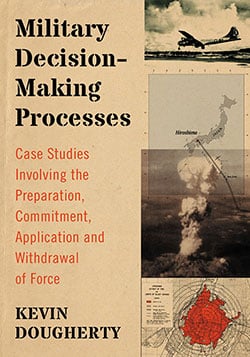Military Decision-Making Processes
Case Studies Involving the Preparation, Commitment, Application and Withdrawal of Force
$29.95
In stock
About the Book
President Bill Clinton, speaking as might any commander-in-chief, on the eve of his decision to deploy ground troops to Bosnia in 1995, declared he had “no responsibility more grave than putting soldiers in harm’s way.” Such a statement suggests that a study of the decision-making process associated with the weighty matters of using force would be enlightening. Indeed, it is. The decision-making process is far from standardized nor is it simple.
While all individuals associated with important decisions about national security and the lives of America’s service members take their responsibilities seriously, the processes by which they reach their conclusions are varied and complicated. The book traces eight traditional and emerging theories or models of decision-making by first explaining the components of each model and then by analyzing its practical application through three case studies. Each chapter concludes with a discussion of the utility and explanatory power of the particular model.
Instructors considering this book for use in a course may request an examination copy here.
About the Author(s)
Bibliographic Details
Kevin Dougherty
Format: softcover (7 x 10)
Pages: 172
Bibliographic Info: 13 photos, notes, bibliography, index
Copyright Date: 2014
pISBN: 978-0-7864-7798-2
eISBN: 978-1-4766-0407-7
Imprint: McFarland
Table of Contents
Table of Contents
Preface 1
Introduction 3
Chapter 1: The Rational Actor Model 7
Example 1: Truman’s Decision to Use the Atomic Bomb on Japan, 1945 7
Example 2: Reagan’s Decision to Bomb Libya, 1986 12
Example 3: Bush’s Decision to Halt Operation Desert Storm, 1991 16
Utility of the Rational Actor Model 18
Chapter 2: Prospect Theory 20
Example 1: Washington’s Decision to Attack Trenton, 1776 20
Example 2: Meade’s Decision Not to Pursue Lee After Gettysburg, 1863 23
Example 3: Clinton’s Decision to Withdraw from Somalia, 1993 28
Utility of the Prospect Theory 31
Chapter 3: Poliheuristic Theory 33
Example 1: Eisenhower’s Decision Not to Intervene in Hungary, 1956 34
Example 2: Kennedy’s Authorization of the Bay of Pigs, 1961 37
Example 3: Johnson’s Decision to De-escalate US Involvement in Vietnam, 1968 42
Utility of the Poliheuristic Theory 49
Chapter 4: The Bureaucratic Model 50
Example 1: The Confederate Departmental System’s Impact on the Vicksburg Campaign, 1862–1863 51
Example 2: The Army–Air Force Helicopter Rivalry, 1950s–1960s 54
Example 3: The Department of State and the Department of Defense and the Multinational Peacekeeping Force in Beirut, 1982 60
Utility of the Bureaucratic Model 65
Chapter 5: The Organizational Process Model 66
Example 1: Strategic Formulation in the Vietnam War, 1960s–1970s 66
Example 2: The Decision to Abort the Iranian Hostage Rescue Mission, 1980 71
Example 3: The Federalization of the California Army National Guard During the Los Angeles Riot, 1992 75
Utility of the Organizational Process Model 80
Chapter 6: The Small Group Model 81
Example 1: The Blockade Board in the Civil War, 1861 81
Example 2: The Executive Committee During the Cuban Missile Crisis, 1962 87
Example 3: The Restricted Interagency Group in Developing a Strategy Toward Nicaragua, 1980s 91
Utility of the Small Group Model 96
Chapter 7: The Elite Theory 97
Example 1: The Influence of the Congressional Black Caucus in the Decision to Intervene in Haiti, 1993 and 1994 97
Example 2: The Role of the Media in the Decision to Intervene in Somalia, 1992 104
Example 3: The Agenda of Secretary of State Madeline Albright in the Decision to Intervene in Kosovo, 1999 109
Utility of the Elite Theory 114
Chapter 8: The Pluralist Model 115
Example 1: Conscription in the Confederate Army, 1861–1864 115
Example 2: The Reflagging of Kuwaiti Tankers in the Midst of the Iran-Iraq War, 1987–1988 122
Example 3: The Implementation Force (IFOR) in Bosnia, 1995 129
Utility of the Pluralist Model 135
Epilogue 137
Chapter Notes 139
Bibliography 153
Index 161





